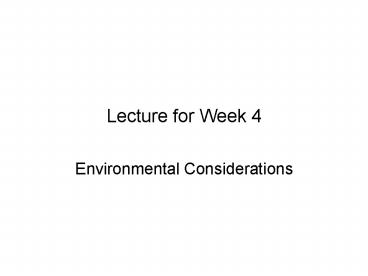Lecture for Week 4 PowerPoint PPT Presentation
1 / 47
Title: Lecture for Week 4
1
Lecture for Week 4
- Environmental Considerations
2
Environmental Considerations
- References WSDOT Pavement Guide, Volume 2,
Section 3.0, Environment PGI, Module 4-Section 4 - Topics
- Climate information and temperature variations
- Frost action
3
EnvironmentA Few Climate Stats
4
EnvironmentTemperature Variation
5
EnvironmentTemperature Variation
6
Temperature and Pavements
- HMA and PG binders
- PCCP
- Expansion and contraction
- Slab curling
7
PCCP and HMA
8
PCCP Expansion and Contraction
9
PCC Slab Curling
10
PCC Slab CurlingEdge Stress
11
PCC Slab CurlingInterior Stress
12
PCC Slab CurlingCorner Stress
13
PCC Slab CurlingRadius of Relative Stiffness
14
PCC Slab CurlingC coefficients
15
Freezing and Thawing Effects
- Frost heave and thaw weakening
- Frost heave
- Caused by the creation of ice lenses and largely
driven through capillary rise in frost
susceptible soils. - Three conditions necessary for ice lenses
- Frost susceptible soil
- Subfreezing temperatures
- Water
16
In addition
- Remove any of the 3 conditions and frost effects
are eliminated. If the 3 conditions occur
uniformly, heaving will be uniformotherwise
differential heaving will occur resulting in
pavement cracking and roughness. This is more
likely to occur where - Subgrades change from clean (NFS) sands to silty
frost susceptible materials. - Abrupt transitions from cut to fill with
groundwater close to the surface. - Drains, culverts, etc, often result in
differential heaving due to different backfill
material or compaction. Pipes that can change the
thermal conditions (ie, that add or remove heat).
17
Thaw Weakening
18
Thaw weakening can lead to this
19
Sources of Water
Source WSDOT Pavement Guide, Volume 2, Figure
2.27 (pdf)
20
Frost Heave Process and Related Damage
21
County road in Ferry County which shows frost
heavesnote location of cut and fill sections.
22
SR 20 Okanogan CountyLongitudinal cracks due to
ice lenses growing parallel to shoulder slope.
23
Capillary Rise
24
Casagrande Criterion
- In 1932, Arthur Casagrande noted following
rule-of-thumb - "Under natural freezing conditions and with
sufficient water supply one should expect
considerable ice segregation in non-uniform soils
containing more than 3 of grains smaller than
0.02 mm, and in very uniform soils containing
more than 10 percent smaller than 0.02 mm. No ice
segregation was observed in soils containing less
than 1 percent of grains smaller than 0.02 mm,
even if the groundwater level is as high as the
frost line."
25
USACE Frost Design Soil Classification and
Associated USC Types
Source WSDOT Pavement Guide, Volume 2, Table 2.9
(pdf)
26
WSDOT Granular Base Courses
- WSDOT uses crushed surfacing base course (CSBC)
as a frost resistant crushed aggregate because it
has a maximum of only 7.5 passing the 0.075 mm
(No. 200) sieve.
27
Mitigating Frost Action
- Limit the depth of frost into the subgrade soils.
- Removing and replacing frost-susceptible
subgrade. - Design the pavement structure based on reduced
subgrade support. - Provide a capillary break.
28
But how do you estimate depth of freeze under a
new or existing pavement?
29
Calculation of Freezing Index
30
Mean Freezing Index Contours
31
Design Freezing Index Contours
32
Depth of Freeze Based on Design Freezing Index
for Fine-Grain Soil
33
Depth of Freeze Based on Design Freezing Index
for Coarse-Grain Soil
34
WSDOT Design for Freezing Conditions
Source WSDOT Pavement Guide, Volume 2, p. 2-106
35
Depth of Freeze Based on WSDOT Field
MeasurementsWinters 1949 and 1950
36
Modified Berggren Equationor how to calculate
the expected depth of freeze or thaw
37
Stefan Formula
- Assumes latent heat of the soil is the only heat
which must be removed when freezing the soil. - This is an over simplification of the actual
conditions.
38
Stefan Formula
39
Stefan Formula
Source WSDOT Pavement Guide, Volume 2, p. 2-118
40
Stefan Formula
- Refer to Para 3.2.2.2 and Equation 2.1
- ?(?T)(dt) surface freezing index (F-hr).
Freezing index normally expressed as F-days.
Thus expression is (2)(24)(n)(FI) 48nFI
41
Modified Berggren Equation
- Best reference for Assignment No. 3 is PGI
(1995), Volume 2, Section 2.0, Paragraph 3.2.2 - Modified Berggren Equation
42
Inputs
- k thermal conductivity BTU/hr-ft2-F/ft
-
BTU/hr-ft-F - k for pavement material\s f(density, mc)
- k for HMA?
43
Inputs
- kavg
- Average thermal conductivity of each layer.
First, you must estimate the layer moisture
content and dry density (see Para 3.2). If you
want to use figures for determination of k, refer
to Figs 2.28-2.30. Get k values for frozen and
unfrozen cases, then average.
44
Inputs
- Sources for equation inputs
- FI Average FI is given for most Washington State
cities in Table 2.10. Use the contour map (Fig
2.33) for Design FI. Units are F-days. - n Adjusts air FI (which is what you get from
Table 2.10 or Fig 2.33) to surface FI. Refer to
Typical Values in Para 3.2.1.5(c)(i). - n surface freezing index/air
freezing index
45
Inputs
- Sources for equation inputs
- L Latent heat is the heat that must be removed
to convert an unfrozen soil to frozen at 32F.
Function of the layer density and moisture
content (refer to Para 3.2.1.4). - L (144 BTU/lb)(w)(?d) BTU/ft3
46
Modified Berggren Equation
- Must deal with multiple layers for most
conditions (and Assignment 3) - Use the following
47
Use of Modified Berggren Equation
- How do you calculate (L/k)eff?
- First, assume a depth of freeze, x
- Second, use
This is the assumed total depth of freeze (ft)

